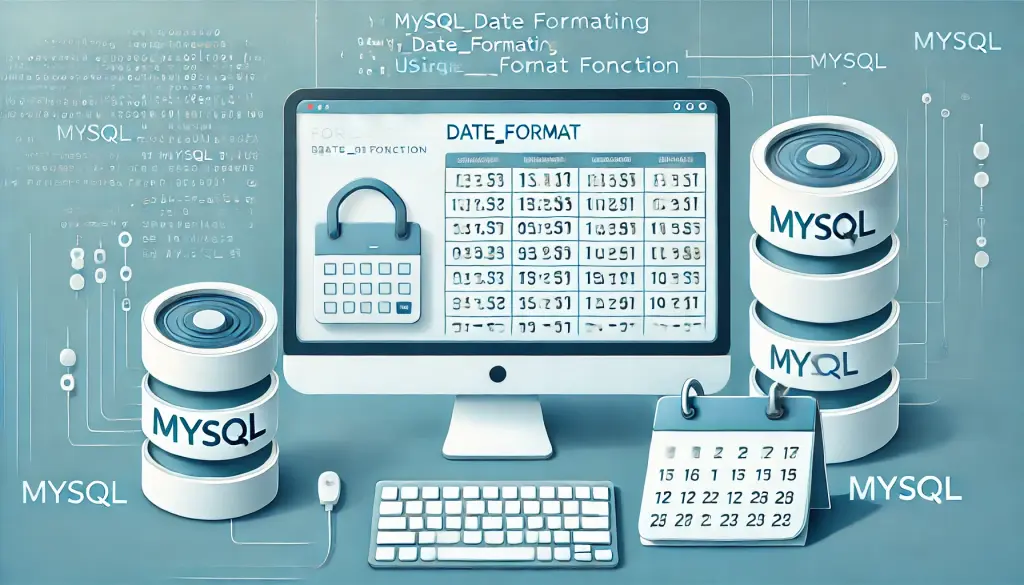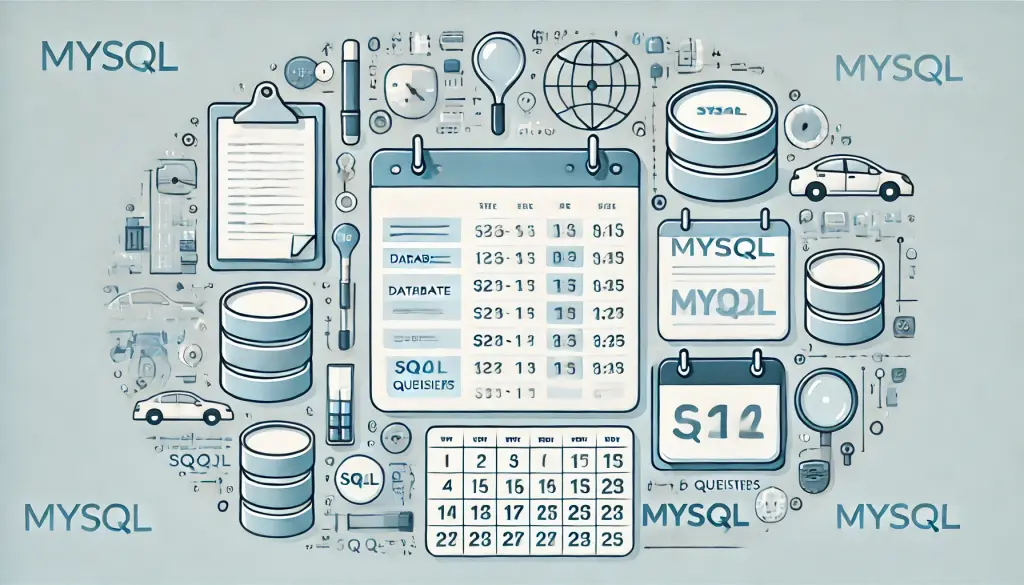1. Before Learning MySQL Date Formatting: The Basics
Managing date data in a database plays a critical role in every system. In MySQL, accurate storage and proper formatting are essential. Here, we’ll introduce the basics of how dates are stored and displayed, and explain the DATE_FORMAT function, which is useful for formatting date outputs.
1.1 MySQL Date Types and Their Features
MySQL provides multiple data types for handling dates and times. Understanding their use cases helps you choose the right type and optimize database performance.
- DATE Type
Stores dates in the formatYYYY-MM-DD. Suitable for simple date-only data (e.g., birthdays or event dates). Example:2024-10-19 - DATETIME Type
Stores both date and time in the formatYYYY-MM-DD HH:MM:SS. Useful for logs or records where time is required. Example:2024-10-19 15:30:45 - TIMESTAMP Type
Stores data as a UNIX timestamp (the number of seconds since January 1, 1970) and is often used in systems that span different time zones. You can retrieve the current timestamp withCURRENT_TIMESTAMP.
Choosing the right date type based on your application’s requirements is crucial for accuracy and query efficiency.
1.2 Difference Between Storage and Display
When MySQL stores dates, it uses a standard format. However, users often need dates displayed in a more readable or localized way. That’s where the DATE_FORMAT function comes in—it lets you output stored data in a customized format.
In the next section, we’ll look at how DATE_FORMAT works and practical ways to use it.

2. Basic Usage of the DATE_FORMAT Function
The DATE_FORMAT function is used to format stored dates into the desired output format. By using flexible format specifiers, you can display dates in a variety of styles.
2.1 Syntax of DATE_FORMAT
DATE_FORMAT(date, format)date: The date value you want to format (DATE, DATETIME, TIMESTAMP, etc.).format: A string that specifies the output format, using format specifiers with the%symbol.
For example, this query converts a date into the YYYY/MM/DD format:
SELECT DATE_FORMAT('2024-10-19', '%Y/%m/%d');Result:
2024/10/192.2 Common Format Specifiers
The DATE_FORMAT function supports many format specifiers for customizing date and time outputs. Here are some common ones:
%Y: Four-digit year (e.g., 2024)%m: Two-digit month (01–12)%d: Two-digit day (01–31)%W: Weekday name (e.g., Saturday)%H: Hour in 24-hour format (00–23)%i: Minutes (00–59)%s: Seconds (00–59)
For example, the following query outputs the weekday along with year, month, and day:
SELECT DATE_FORMAT('2024-10-19', '%W, %Y-%m-%d');Result:
Saturday, 2024-10-192.3 Output in Japanese Format
You can also use DATE_FORMAT for localized outputs. For instance, this query returns the date in the Japanese format YYYY年MM月DD日:
SELECT DATE_FORMAT('2024-10-19', '%Y年%m月%d日');Result:
2024年10月19日This format is commonly used in Japanese reports, invoices, and official documents.
3. Advanced DATE_FORMAT Techniques
DATE_FORMAT becomes even more powerful when combined with other MySQL functions. Let’s look at some useful techniques for handling date operations.
3.1 Combining with Other Date Functions
You can combine DATE_FORMAT with functions like DATE_ADD and DATE_SUB for dynamic date calculations.
Example: Add One Month to a Date and Format It
SELECT DATE_FORMAT(DATE_ADD('2024-10-19', INTERVAL 1 MONTH), '%Y-%m-%d');Result:
2024-11-19This is useful for generating dynamic reports and processing date-based updates.
3.2 Using with STR_TO_DATE
The STR_TO_DATE function converts a string into a date type. Combined with DATE_FORMAT, you can parse strings into valid date data and then format them as needed.
Example: Convert a String into a Date and Apply Formatting
SELECT DATE_FORMAT(STR_TO_DATE('2024年10月19日', '%Y年%c月%e日'), '%Y/%m/%d');Result:
2024/10/19This allows you to handle complex string-based dates and format them correctly.

4. Common Real-World Date Formats
Here are some frequently used date formats in business and system applications.
4.1 Date with Slashes
SELECT DATE_FORMAT('2024-10-19', '%Y/%m/%d');Result:
2024/10/19This format is widely used in web forms and user interfaces.
4.2 ISO 8601 Format
SELECT DATE_FORMAT('2024-10-19', '%Y-%m-%d');Result:
2024-10-19ISO 8601 is the international standard and ideal for data exchange between systems.
4.3 Displaying Weekday and Month Name
SELECT DATE_FORMAT('2024-10-19', '%M %W');Result:
October SaturdayThis is useful for event schedules and calendar views.
5. Conclusion
The DATE_FORMAT function is a powerful tool for flexible date formatting in MySQL. From simple formatting to advanced use cases combined with other functions, it is highly versatile.
By using functions like STR_TO_DATE and DATE_ADD together, you can achieve even more dynamic data processing. Apply the techniques covered in this article to efficiently manage date data and optimize your system or application.
Continue leveraging MySQL’s features to improve database operations and build more refined systems.



